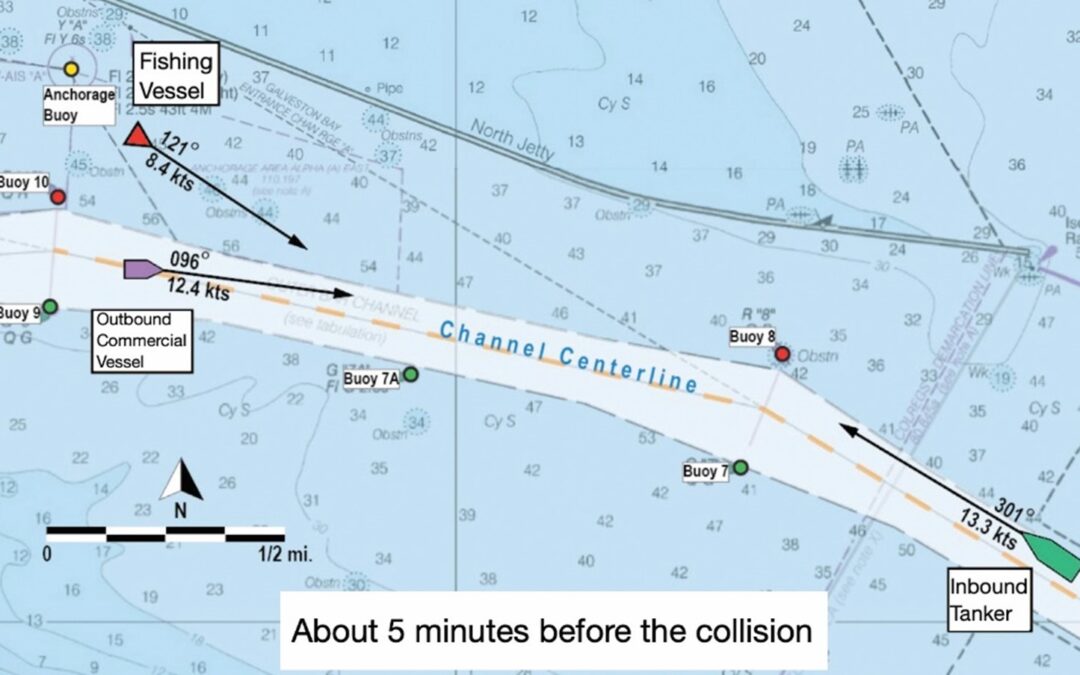The Nautical Institute stresses that slowing down your ship in near zero visibility is always the sensible thing to do. In its latest Mars Report, a loaded tanker collided with a fishing vessel with an approach speed of almost 22 knots.
The Nautical Institute gathers reports of maritime accidents and near-misses. It then publishes these so-called Mars Reports (anonymously) to prevent other accidents from happening. A summary of this incident:
A loaded tanker was inbound under pilotage, making 11 knots in a restricted waterway. Visibility was initially low at about 0.5 nm, but the pilot told the master that visibility was clear in the harbour and had been clearing for the last few hours. They agreed to continue the inbound transit. The pilot set up two portable pilot units (PPUs) and informed the master that he would hail outbound vessels to arrange port-to-port passages. A crew member was sent to the bow as lookout/anchor standby. The fog horn was sounding from the forward mast.
Meanwhile, an outbound fishing vessel ahead had turned to starboard and was heading towards the channel at an angle of intersection of about 30°. On the tanker at this time, the pilot planned to meet an outbound commercial vessel by moving to the extreme right side of the channel, giving the centre channel to the outbound ship.
Also read: Nautical Institute: ‘Confirm other vessel’s movements instead of making assumptions’
At 1535, the tanker’s pilot hailed the fishing vessel twice on VHF radio. Although the operator of the fishing vessel did not respond, electronic data shows that, shortly after the first attempted hail, the fishing vessel came 19 degrees to port. The predicted vector from the new heading, just north and slightly parallel to the outskirts of the channel boundary, indicated that the fishing vessel would continue to enter the channel at a very shallow angle, crossing ahead of the inbound tanker at about 8.4 knots.
About one minute after the failed VHF communication with the fishing vessel’s operator, the tanker’s pilot sounded five short blasts. Electronic data shows the fishing vessel maintained its heading nonetheless.
About ninety seconds after the first danger signal and some ten seconds after a second danger signal, the tanker collided with the fishing vessel, which capsized almost immediately. One crew member from the fishing vessel was rescued from the water alive. Another crew member was recovered from the water and pronounced deceased. The bodies of two other crew members were found within the wreck.
Investigation findings
The subsequent official investigation could not determine why the fishing vessel’s operator did not slow or take substantial action to avoid transiting into the channel directly in front of the tanker, or what the captain of the fishing vessel was doing in the minutes leading up to the collision.
It is possible the captain was away from the conn, was distracted, fell asleep, was unsure of what action to take, or was otherwise unable to respond to the developing situation. The captain’s failure to slow his vessel, act on his automatic radar plotting aid (ARPA)’s information or respond to the tanker pilot’s communications may have been due to a medical event.
Also read: ‘Don’t assume other vessels will stay clear of you’
Advice from The Nautical Institute
- Much as in the previous Mars Report, early communication can be an effective measure in averting close quarters situations. The use of VHF radio can help to dispel assumptions and provide operators with the information needed to better assess each vessel’s intentions.
- Never assume the actions of another vessel will be coherent or logical. Many jurisdictions still do not require small vessel operators to pass competency requirements. Small boats should be watched carefully by professional mariners.
- In near zero visibility, slow down. The resultant approach speed of the tanker and the fishing vessel was nearly 22 knots.
Mars Reports
This accident was covered in the Mars Reports, originally published as Mars 202206, that are part of Report Number 352. A selection of this Report was also published in SWZ|Maritime’s March 2022 issue. The Nautical Institute compiles these reports to help prevent maritime accidents. That is why they are also published on SWZ|Maritime’s website.
More reports are needed to keep the scheme interesting and informative. All reports are read only by the Mars coordinator and are treated in the strictest confidence. To submit a report, please use the Mars report form.








